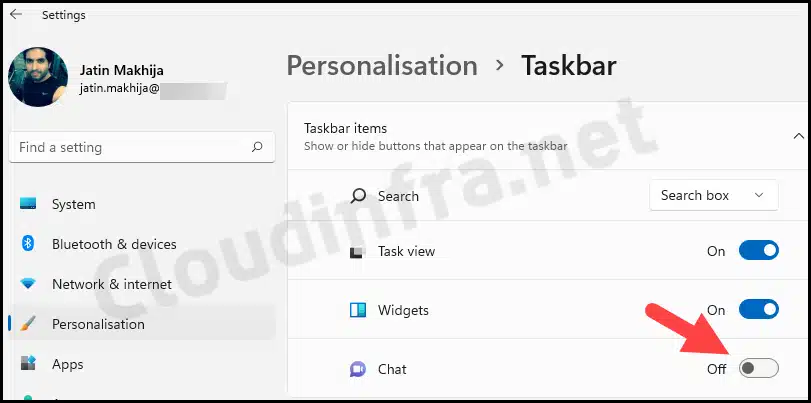In this post, I will show you how to use Intune to remove Teams chat Icon from Windows 11 taskbar. Personal version of teams app is installed by default on Windows 11 devices and pinned to the taskbar. You can sign in to this app using your Microsoft account credentials only. It does not work with your corporate credentials, work, or school account.
Teams app has two versions, first is for personal use and comes pre-installed on Windows 11. The second version is for business users, and it’s not pre-installed and deployed separately.
You can remove personal version of Teams chat icon from the taskbar using various ways. The simplest way to remove it on Intune-managed devices is by using a settings catalog policy called Configure Chat icon.
Other ways to remove Personal Teams chat Icon:
- Using OMA-URI setting.
- Using Windows registry.
- Using PowerShell scripts.
- Using a Group Policy object.
- Manual method to Show/Hide Teams chat Icon.

Contents
Remove Teams Chat Icon from Taskbar Intune Policy
Let’s create a device configuration profile using a settings catalog policy Configure Chat icon.
- Sign in to the Intune admin center > Devices > Configuration > Create > New Policy.
- Platform: Windows 10 and later.
- Profile type: Settings Catalog.
- Basics: Provide a Name and Description of the Profile.
- Configuration settings: Click on + Add settings and search for configure chat icon in the settings picker. Click on the Experience Category and select the Configure Chat Icon setting.

- Select Disabled from the drop-down to disable it completely. When you select Disabled, Users won’t be able to change the setting to show or hide Teams chat Icon.
- Show: If you choose Show from the drop-down menu, the Chat Icon will appear on the taskbar. Users can also change the setting to show or hide it using the Settings app.
- Hide: Choosing Hide from the drop-down menu will hide the Chat Icon from the taskbar, and users can change the setting to show or hide it using the Settings app.
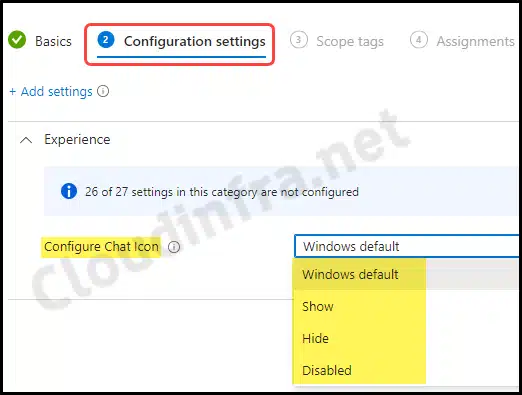
- Selected Disabled for Configure Chat Icon.
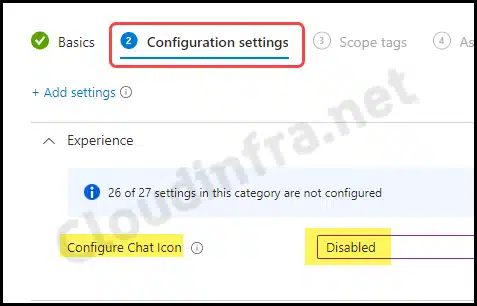
- Scope tags (optional): A scope tag in Intune is an RBAC label you add to resources (policies, apps, devices) to limit which admins can see and manage them. For more Information, read: How to use Scope tags in Intune.
- Assignments: Assign the policy to Entra security groups that contain the target users or devices. As a best practice, pilot with a small set first; once validated, roll it out more broadly. For guidance on assignment strategy, see Intune assignments: User groups vs. Device groups.
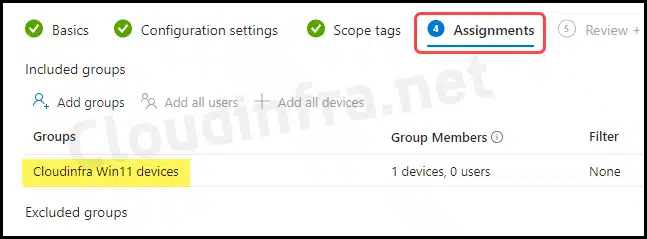
- Review + create: Review the deployment and click on Create.
Sync Intune Policies
The device check-in process might not begin immediately. If you’re testing this policy on a test device, you can manually kickstart Intune sync from the device itself or remotely through the Intune admin center.
Alternatively, you can use PowerShell to force the Intune sync on Windows devices. Restarting the device is another way to trigger the Intune device check-in process.
Monitoring Deployment Progress
To monitor the deployment progress of a Device configuration profile, follow the below steps:
- Sign in to the Intune admin center >Devices > Configuration.
- Choose the Device Configuration profile you want to work with, and at the top of the page, you’ll see a quick view of the Success, Failure, Conflict, Not Applicable, and In Progress status.
- Click on View report to access more detailed information.
End User Experience
I took snapshots before and after configuring the Chat Icon policy. Please find it below:
- Before setting Configure Chat Icon to Disabled, the Teams chat Icon was available in the taskbar. If you go to Settings App > Personalization > Taskbar, you will see a chat icon, and Toggle will be switched on.
- After setting Configure Chat Icon to Disabled, the Teams chat Icon is removed from the taskbar. If you go to Settings App > Personalization > Taskbar, you will no longer see a Chat option.

OMA-URI Setting for Disabling Teams Chat Icon
You can use the OMA-URI setting ./Device/Vendor/MSFT/Policy/Config/Experience/ConfigureChatIcon to enable/disable Teams chat icon on a Windows 11 devices. To control whether it’s shown, hidden, or disabled, you should configure the integer value as follows.
- 1- Show
- 2- Hide
- 3- Disabled
The screenshot below is an example of the configured OMA-URI setting for disabling the Teams chat icon on Windows 11.

You will need to create a Custom device configuration profile on Intune admin center to deploy OMA-URI setting on Windows 10/11 devices. For Step-by-step guide on deployment of an OMA-URI setting, you can refer to blog post Hide Gaming Under Settings On Windows Using Intune blog post.
Note
Registry key for Disabling Teams Chat Icon
To remove Teams chat Icon from Windows 11 taskbar using Windows registry. You can create a registry key called Windows Chat under HKEY_LOCAL_MACHINE\SOFTWARE\Policies\Microsoft\Windows. Then, create a DWORD registry entry under Windows Chat called ChatIcon and set its value to 3.
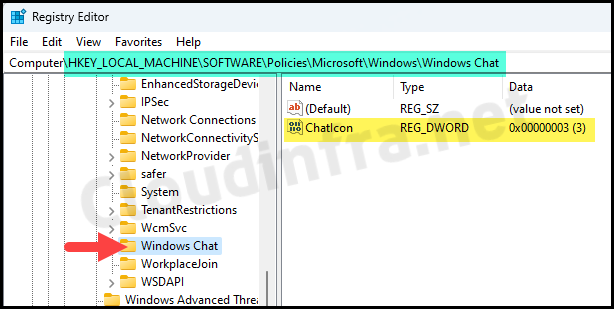
PowerShell Script to Disable Teams chat Icon on Windows 11
To remove the Teams chat icon from the taskbar on Windows 11 devices, you can create a PowerShell script to deploy the necessary registry keys and values. For detailed instructions, please refer to the blog post on how to create a registry key and values using PowerShell and deploy them using Intune remediations.
If you want to remove the default built-in Teams app from Windows 11 completely, you can launch PowerShell as administrator and run the below command:
Remove-appxpackage -package "MicrosoftTeams_21302.202.1065.6968_x64__8wekyb3d8bbwe"
Group Policy for Disabling Teams chat Icon on Windows 11
If you manage your devices through the On-premise Active Directory, you can create a Group Policy Object (GPO) to deactivate the Teams chat icon on Windows 11 devices.
You must Import the Group Policy ADMX template for Windows 11 first and then find the setting Configure the Chat icon on the taskbar under Computer Configuration\Administrative Templates\Windows Component\Chat.
Configure the Chat icon on the taskbar will provide three options, Show, Hide, and Disabled. Set it to Disabled to disable and remove the Teams chat Icon from Windows 11 devices. Link this Group Policy Object to an OU containing devices.
Manually Hide Teams Chat Icon from Windows 11 devices
- Press Win + I keys together to open Settings App.
- Go to Personalization > Taskbar.
- Toggle the switch next to Chat to off and hide Teams chat Icon from taskbar.
